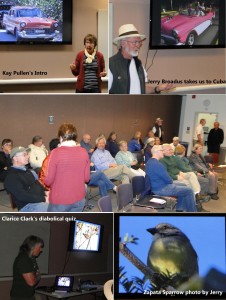Our May 6, 2015, meeting was a great success in spite on meeting in a new venue. It seems you all found it easily, though. We will keep that in mind next time we can’t get the dates we want at the University Place library, which will be the site for the next couple of meetings in June and July. Our program director, Kay Pullen, gave us some ideas of what is coming up soon at ABC and then introduced our guides for the evening.
Jerry Broadus and Clarice Clark recapped their recent visit to Cuba which was directly after the loosening of travel restrictions by the President earlier this year. They will post to this site a summary of current logistics on travel to Cuba, some of which are the same and some which have changed since our last Cuba report from Carole Breedlove and Bill Hagens a couple of years ago. The evening started out with a revolving slide show put together by Clarice of beautiful old American cars still in use in Cuba to the accompaniment of Cuban music played by a group that Jerry & Clarice actually met while there. Later we heard the Frankensteinian stories of how they keep those old cars running. Bicycles and horses seem like the more reliable forms of transportation, and a slide of a 4-lane freeway with just one horse-cart on it showed the reality of transportation on the island.
The good part of the island was certainly the birds. Lack of transportation has served to accidentally preserve some excellent habitat which should become more accessible as travel restrictions for tourists become easier. 26 (soon to be 30) endemics and the majority of Caribbean specialties reward the birder, many of them quite showy, including Cuban Trogon, Cuban Tody, several woodpeckers, and Bee Hummingbird.
Jerry also gave us a report on his recent work in Mexico on the now critically endangered Military Macaw, a stunningly beautiful cavity dweller, dwindling not only because of habitat loss, but also because of the pet bird trade, now being entered by the cartels because it is so lucrative. He opined that perhaps one factor in this was listing a bird as endangered automatically makes it more attractive to this faction, thus endangering it more. His slides and stories about the huge pit where they have their burrows in the sandstone were riveting. These 70 birds have a stable population, perhaps the carrying capacity of the pit, and it never seems to grow no matter how successful they are in breeding. They lay up to 3 eggs, but only raise a single chick.
Clarice then proceeded to give us a diabolical quiz to see what we retained from the Cuban bird slides. I think the group did pretty well on that! The last quiz was not a bird, but a car, complete with field marks! (1951 Cadillac?)
Clarice also passed around some warbler cheat sheets, which are available free to all at this website: http://blog.press.princeton.edu/2013/07/25/downloadable-warbler-guide-quick-finders/
As usual, we all had a good time discussing and learning about our favorite topics.
Click on photos below to enlarge:


Jerry and Clarice promised more info on how to travel to Cuba these days, and it’s now on this site at: http://abcbirding.com/travelcubabirding